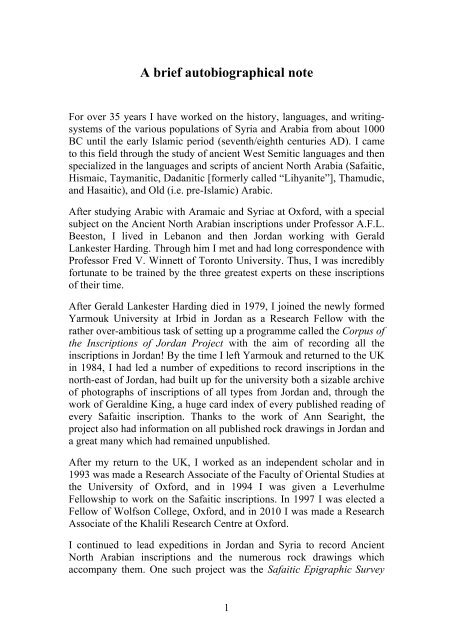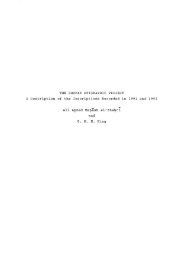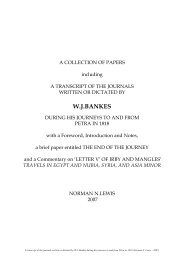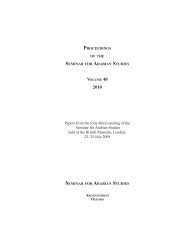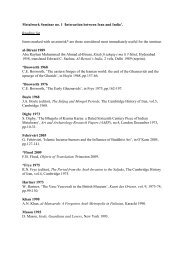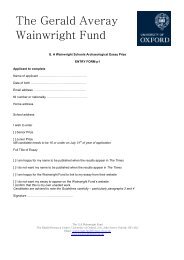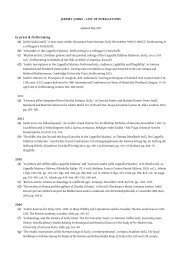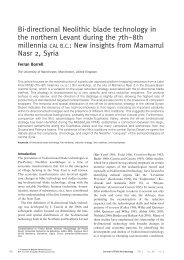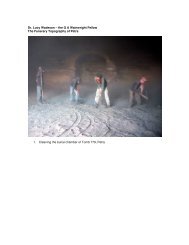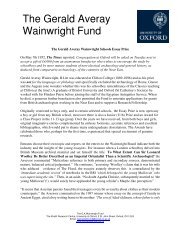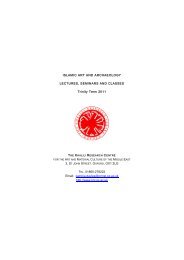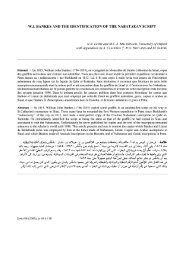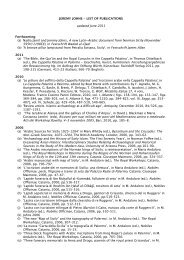A brief autobiographical note - Khalili Research Centre for the Arts ...
A brief autobiographical note - Khalili Research Centre for the Arts ...
A brief autobiographical note - Khalili Research Centre for the Arts ...
You also want an ePaper? Increase the reach of your titles
YUMPU automatically turns print PDFs into web optimized ePapers that Google loves.
A <strong>brief</strong> <strong>autobiographical</strong> <strong>note</strong><br />
For over 35 years I have worked on <strong>the</strong> history, languages, and writingsystems<br />
of <strong>the</strong> various populations of Syria and Arabia from about 1000<br />
BC until <strong>the</strong> early Islamic period (seventh/eighth centuries AD). I came<br />
to this field through <strong>the</strong> study of ancient West Semitic languages and <strong>the</strong>n<br />
specialized in <strong>the</strong> languages and scripts of ancient North Arabia (Safaitic,<br />
Hismaic, Taymanitic, Dadanitic [<strong>for</strong>merly called “Lihyanite”], Thamudic,<br />
and Hasaitic), and Old (i.e. pre-Islamic) Arabic.<br />
After studying Arabic with Aramaic and Syriac at Ox<strong>for</strong>d, with a special<br />
subject on <strong>the</strong> Ancient North Arabian inscriptions under Professor A.F.L.<br />
Beeston, I lived in Lebanon and <strong>the</strong>n Jordan working with Gerald<br />
Lankester Harding. Through him I met and had long correspondence with<br />
Professor Fred V. Winnett of Toronto University. Thus, I was incredibly<br />
<strong>for</strong>tunate to be trained by <strong>the</strong> three greatest experts on <strong>the</strong>se inscriptions<br />
of <strong>the</strong>ir time.<br />
After Gerald Lankester Harding died in 1979, I joined <strong>the</strong> newly <strong>for</strong>med<br />
Yarmouk University at Irbid in Jordan as a <strong>Research</strong> Fellow with <strong>the</strong><br />
ra<strong>the</strong>r over-ambitious task of setting up a programme called <strong>the</strong> Corpus of<br />
<strong>the</strong> Inscriptions of Jordan Project with <strong>the</strong> aim of recording all <strong>the</strong><br />
inscriptions in Jordan! By <strong>the</strong> time I left Yarmouk and returned to <strong>the</strong> UK<br />
in 1984, I had led a number of expeditions to record inscriptions in <strong>the</strong><br />
north-east of Jordan, had built up <strong>for</strong> <strong>the</strong> university both a sizable archive<br />
of photographs of inscriptions of all types from Jordan and, through <strong>the</strong><br />
work of Geraldine King, a huge card index of every published reading of<br />
every Safaitic inscription. Thanks to <strong>the</strong> work of Ann Searight, <strong>the</strong><br />
project also had in<strong>for</strong>mation on all published rock drawings in Jordan and<br />
a great many which had remained unpublished.<br />
After my return to <strong>the</strong> UK, I worked as an independent scholar and in<br />
1993 was made a <strong>Research</strong> Associate of <strong>the</strong> Faculty of Oriental Studies at<br />
<strong>the</strong> University of Ox<strong>for</strong>d, and in 1994 I was given a Leverhulme<br />
Fellowship to work on <strong>the</strong> Safaitic inscriptions. In 1997 I was elected a<br />
Fellow of Wolfson College, Ox<strong>for</strong>d, and in 2010 I was made a <strong>Research</strong><br />
Associate of <strong>the</strong> <strong>Khalili</strong> <strong>Research</strong> <strong>Centre</strong> at Ox<strong>for</strong>d.<br />
I continued to lead expeditions in Jordan and Syria to record Ancient<br />
North Arabian inscriptions and <strong>the</strong> numerous rock drawings which<br />
accompany <strong>the</strong>m. One such project was <strong>the</strong> Safaitic Epigraphic Survey<br />
1
Programme (1996–2003), <strong>the</strong> aim of which was to rediscover and record<br />
properly <strong>the</strong> thousands of Safaitic inscriptions copied in <strong>the</strong> nineteenth<br />
and early twentieth centuries of which no photographs existed. This was<br />
very successful and all but two of <strong>the</strong> sites were rediscovered. In <strong>the</strong> mid-<br />
1990s, I also led a rescue survey in <strong>the</strong> area of al-Namārah in sou<strong>the</strong>rn<br />
Syria where large numbers of inscriptions were in danger of being<br />
destroyed in <strong>the</strong> course of building a dam. The inscriptions from <strong>the</strong>se<br />
surveys have already been entered in <strong>the</strong> Safaitic Database, see below.<br />
Since <strong>the</strong> vast majority of <strong>the</strong> Safaitic, Hismaic, and Thamudic<br />
inscriptions are graffiti written by ancient nomads, <strong>the</strong> study of <strong>the</strong>se<br />
texts has led me to work on <strong>the</strong> history of <strong>the</strong> Near Eastern nomads in <strong>the</strong><br />
pre-Islamic period and on <strong>the</strong> varied and often surprising uses of literacy,<br />
and <strong>the</strong> relationships of literate and non-literate communities in <strong>the</strong><br />
ancient world.<br />
I have also worked <strong>for</strong> many years on inscriptions in Nabataean Aramaic,<br />
and have almost completed a detailed study of how <strong>the</strong> Nabataean script<br />
evolved into <strong>the</strong> Arabic script. Alongside this, I am working on an<br />
analysis of what is known of <strong>the</strong> Arabic language in <strong>the</strong> pre-Islamic<br />
period. I have also worked on o<strong>the</strong>r <strong>for</strong>ms of <strong>the</strong> Aramaic script and in<br />
April 2011, published a detailed study of <strong>the</strong> development of <strong>the</strong> Aramaic<br />
inscriptions on coins issued by a series of women rulers in eastern Arabia<br />
during <strong>the</strong> Hellenistic period.<br />
I am <strong>the</strong> academic director of <strong>the</strong> Ancient Arabia: Languages and<br />
Cultures website at <strong>the</strong> <strong>Khalili</strong> <strong>Research</strong> <strong>Centre</strong>, Ox<strong>for</strong>d. This was set up<br />
in 2010 to host previously unpublished material connected with ancient<br />
Arabia, including large numbers of pre-Islamic inscriptions. Already, <strong>the</strong><br />
fundamental work on <strong>the</strong> Hismaic inscriptions by <strong>the</strong> late Geraldine King<br />
(her previously unpublished doctoral <strong>the</strong>sis) and a database of <strong>the</strong> names<br />
and vocabulary of <strong>the</strong> Hismaic inscriptions have been placed on this<br />
website, toge<strong>the</strong>r with <strong>the</strong> report on <strong>the</strong> 800 inscriptions from Dhofar in<br />
an, as yet, undeciphered script which were recorded by Ali Ahmad al-<br />
Mahash al-Shahri and Geraldine King in <strong>the</strong> early 1990s. The site also<br />
makes available <strong>for</strong> <strong>the</strong> first time a transcription by Norman N. Lewis of<br />
<strong>the</strong> Journal kept by William John Bankes on his visit to Petra in 1818,<br />
only <strong>the</strong> second visit by a European to <strong>the</strong> site after its rediscovery by<br />
John Lewis Burkhardt in 1812. This transcription is accompanied by<br />
photographs of <strong>the</strong> original document.<br />
The Safaitic Database Online This is based at <strong>the</strong> <strong>Khalili</strong> <strong>Research</strong><br />
<strong>Centre</strong>, Ox<strong>for</strong>d and is <strong>the</strong> result of many years of work. I started it in <strong>the</strong><br />
mid 1990s and now it contains almost 28,000 of <strong>the</strong> approximately<br />
2
30,000 known Safaitic inscriptions. These are graffiti carved by nomads<br />
on <strong>the</strong> rocks of <strong>the</strong> desert in sou<strong>the</strong>rn Syria, eastern Jordan, and nor<strong>the</strong>rn<br />
Saudi Arabia between <strong>the</strong> first century BC and <strong>the</strong> fourth century AD.<br />
Many of <strong>the</strong>m are remarkably in<strong>for</strong>mative and <strong>the</strong>y are our only firsthand<br />
source <strong>for</strong> <strong>the</strong> history, way of life, and language of <strong>the</strong>se nomads,<br />
who were not literate at any o<strong>the</strong>r period. They also in<strong>for</strong>m us of <strong>the</strong>ir<br />
relations with each o<strong>the</strong>r and with <strong>the</strong> external powers (Rome, <strong>the</strong> Jewish<br />
and Nabataean states, etc.). They are mostly published in scattered books<br />
and articles in a number of different languages and are often difficult to<br />
access. The aim of <strong>the</strong> project has been to create an easily updatable<br />
corpus in <strong>the</strong> <strong>for</strong>m of an online database which will contain<br />
transliterations, translations, commentaries, and as much ancillary<br />
in<strong>for</strong>mation as possible as well as photographs <strong>for</strong> each text whenever<br />
<strong>the</strong>se are available. The database is already online with a sample of 3420<br />
inscriptions, and funds are being sought <strong>for</strong> <strong>the</strong> completion of <strong>the</strong> project.<br />
The Online Database of <strong>the</strong> Inscriptions of Ancient North Arabia<br />
[ODIANA]. This is an extension of <strong>the</strong> SDO to include all <strong>the</strong> o<strong>the</strong>r<br />
Ancient North Arabian inscriptions (Taymanitic, Dadanitic, “Thamudic”,<br />
Hismaic, and Hasaitic) and <strong>the</strong> handful of Old (i.e. pre-Islamic) Arabic<br />
inscriptions. It is being prepared in collaboration with <strong>the</strong> Corpus of<br />
South Arabian Inscriptions based at <strong>the</strong> University of Pisa and <strong>the</strong> Digital<br />
Archive <strong>for</strong> <strong>the</strong> Study of pre-Islamic Arabian Inscriptions funded by <strong>the</strong><br />
European <strong>Research</strong> Foundation. Toge<strong>the</strong>r with <strong>the</strong>m, it is hoped to<br />
provide a single portal through which all <strong>the</strong> inscriptions of ancient<br />
Arabia North and South Arabia can be searched.<br />
The inscriptions of <strong>the</strong> oasis of Tayma (Saudi Arabia). I am currently<br />
working with <strong>the</strong> German Archaeological Institute in <strong>the</strong> Saudi-German<br />
Archaeological Mission to Tayma. In particular, I am studying <strong>the</strong><br />
Nabataean and Taymanitic inscriptions found during <strong>the</strong> excavations and<br />
in o<strong>the</strong>r parts of <strong>the</strong> oasis and its environs. I am also producing a<br />
catalogue of all <strong>the</strong> inscriptions in <strong>the</strong> Tayma Museum.<br />
Old Arabic within its linguistic environment. A study of what is<br />
known of <strong>the</strong> Arabic language be<strong>for</strong>e <strong>the</strong> Rise of Islam (mid seventh<br />
century AD), from texts which have survived independently of <strong>the</strong> early<br />
Arab grammarians (i.e. “epigraphic Old Arabic”). Our knowledge of <strong>the</strong><br />
Arabic language dates mainly from <strong>the</strong> Islamic period since up to <strong>the</strong><br />
sixth century AD it seems to have been an almost entirely spoken tongue.<br />
However, <strong>the</strong>re is a small but growing number of pre-Islamic texts in <strong>the</strong><br />
(epigraphic Old) Arabic language, transcribed in a variety of scripts<br />
normally used <strong>for</strong> o<strong>the</strong>r languages. The study deals not only with <strong>the</strong><br />
linguistic features of Old Arabic, but with <strong>the</strong> development of <strong>the</strong> Arabic<br />
3
script, its orthographic conventions, its alphabetic letter-orders, and <strong>the</strong><br />
epigraphic Old Arabic "fossils" which can be found in <strong>the</strong> language of <strong>the</strong><br />
Islamic period. It places <strong>the</strong>se within <strong>the</strong> context of <strong>the</strong> o<strong>the</strong>r languages<br />
and scripts which were in use in Arabia and its neighbours in <strong>the</strong> first half<br />
millennium of <strong>the</strong> Christian era. An article on <strong>the</strong> subject has been<br />
contributed to volume 3 of <strong>the</strong> Encyclopedia of Arabic Language and<br />
Linguistics (Leiden: Brill, 2008: 464–477), and a book on Old Arabic<br />
within its linguistic environment is in preparation.<br />
4


